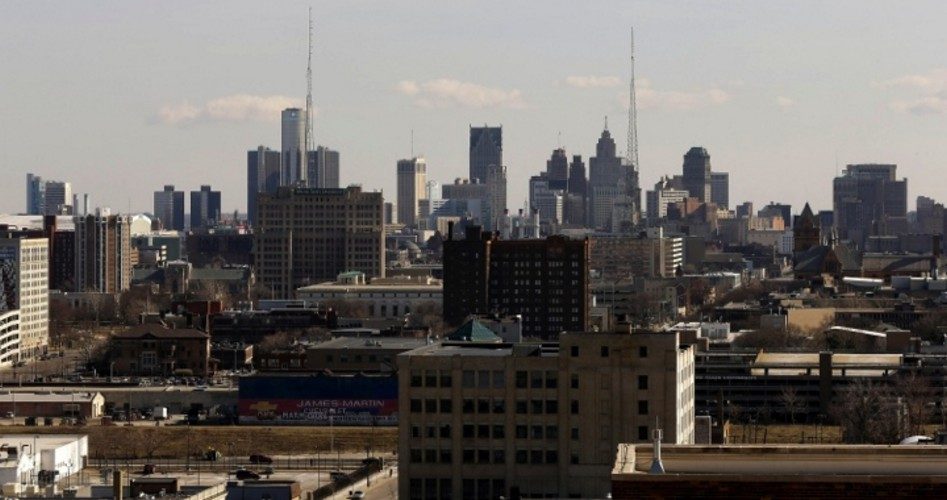
At the conclusion of Friday’s two-hour meeting of more than 180 of Detroit’s creditors, unions, and pension trustees, Emergency Manager Kevyn Orr’s plan to rescue the city from bankruptcy was met with predictable responses: lawsuits and strikes.
It was an altar call to accept reality, but denial, anger, and threats were the response of many. One unnamed bond holder said, “It’s just too much. It is an unprecedented amount to ask.” Mike Mulholland, secretary of American Federation of State, County and Municipal Employees (AFSCME) Local #207, was equally blunt: “When you’re backed into a corner, the only thing you can do is fight and the only way we can fight is to strike.”
Orr was ready for them. In his 134-page proposal, he blamed “financial mismanagement, a shrinking population, [and] a dwindling tax base … over the past 45 years [which] have brought Detroit to the brink of financial and operational ruin.” Indeed, his proposal spelled out the denial of reality that Mayor Dave Bing and his city council had been enjoying for years when it showed that Bing’s people thought that the annual deficit for the city for Fiscal Year 2013 was just $47 million when the actual deficit is more than twice that, and for FY 2014 is estimated to approach $200 million. It’s no wonder that Michigan Governor Rick Snyder declared a financial emergency and appointed bankruptcy attorney Kevyn Orr to take over from the city council in March.
The task facing Orr is horrifying. Faced with more than $18 billion in debts and just $68 million in the bank, Orr started off the meeting by announcing that the city would not make a $40 million payment due that day on a $2.5 billion certificate of participation (COP). He announced further that the city wouldn’t be making $104 million in pension contributions that are currently due either. In addition, retirees hoping that the city would be providing them with healthcare and full payouts of their pension benefits also received the bad news: They too would be forced to rely on the state’s insurance exchanges to obtain health coverage under ObamaCare or Medicare, and could expect significant reductions in their retirement checks as well, approaching $800 a month in many cases.
Orr’s report was equally blunt for those hoping for a miracle: “The City is Insolvent” (Page 7): “the city is not paying its bills,” the city’s infrastructure is deteriorating, “costs associated with unoccupied property” continue to mount, the city’s credit ratings were borderline “bankrupt” by all three agencies, and “Priority One” police response times had increased in just one year from 30 minutes in 2012 to 58 minutes in 2013. In 2012 Detroit “had the highest rate of violent crime of any U.S. city having a population over 200,000 [Detroit’s population is just over 700,000, 40 percent of what it was 1950], five times the national average.”
There are “approximately 78,000 abandoned and blighted structures in the City, nearly half of which are considered ‘dangerous’ [while there are] 66,000 blighted and vacant lots within the City limits.” There are between 11,000 and 12,000 fires in Detroit every year, most of them occurring in those blighted and abandoned buildings.
Orr’s plan, on the surface, is simple: If the creditors — pension trustees, unions, bond holders, and retirees — will sit still for these massive haircuts, then the city can, under a newly created facility, borrow $2 billion to pay off the $11 billion in unsecured creditors. Orr said that translates, after other demands on that new money, to about 10 cents on every dollar owed. Secured creditors will be slightly better off but they will be asked to take a haircut as well. If the proposal is accepted, lawsuits and strikes notwithstanding, then Orr can take this to court as a pre-packaged bankruptcy, giving him the power to enforce the agreement.
On the other hand, if his proposal can’t get sufficient agreement in the next 30 days from all interested (and now properly chastened) creditors, then he’ll ask the court to grant Detroit bankruptcy protection with himself as trustee. In essence, Orr is dealing from strength: Go along with me now and get the best deal possible, or push me and you’ll get less, it’ll cost more, and it’ll take longer. Said Orr: “I have a very powerful statute. I have an even more powerful Chapter 9. I don’t want to use it, but I am going to accomplish this job. That will happen.”
There’s a constitutional issue here as well. Under the Tenth Amendment, “powers not delegated to the federal government by the Constitution … are reserved to the states,” which means that guarantees in Michigan’s state constitution that protect pension and retirement benefits from federal bankruptcy rulings could be put at risk in a court battle. If a high court rules that federal bankruptcy laws override state protections, then every pension plan in the country thinking it has state protection will be affected negatively, with national and perhaps even international ramifications. The municipal bond market is nearly $4 trillion in size, and such a ruling could, at the very least, unnerve that market, raising the cost of borrowing significantly, forcing other cities bordering on bankruptcy over the edge.
Michael Sweet, an attorney at law firm Fox Rothschild who helped the city of Redmond, California, restructure its finances in order to avoid bankruptcy, noted: “The last thing [union pension funds] may want is for a judge to rule on that … because if the judge ruled on that against them, it would open the floodgates” for similar cases.
Photo of Detroit skyline: AP Images
A graduate of Cornell University and a former investment advisor, Bob is a regular contributor to The New American magazine and blogs frequently at www.LightFromTheRight.com, primarily on economics and politics. He can be reached at [email protected]



